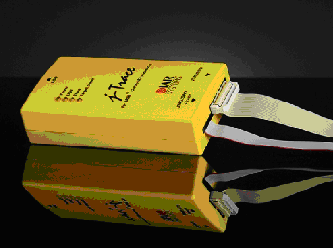infoTECH Feature
March 16, 2009
IAR Demos J-Trace for ARM Cortex-M3Ccores
 By Vivek Naik
By Vivek NaikIAR Systems has demonstrated a high-speed hardware trace probe called J-Trace for ARM Cortex M3 cores.
The offering is a device (pictured below) that plugs and plays with the IAR Embedded Workbench, which provides an integrated development platform inclusive of a debugger and a C and a C++ compiler to support 30 different processors.
The offering is a device (pictured below) that plugs and plays with the IAR Embedded Workbench, which provides an integrated development platform inclusive of a debugger and a C and a C++ compiler to support 30 different processors.

The J-Trace speeds up debugging since development can be performed unhindered on the product hardware and connects to the hyper terminal host PC through a USB 2.0 port which provides a direct current power supply.
The offerings Joint Test Action Group (JTAG) port enables it to work at a high speed (20 MHz) JTAG debug probe in accordance with the IEEE (News - Alert) 1149.1 standard which tests interconnections on printed circuit boards, reports IC pin conditions, measures mini voltages and analyzes sub-blocks within an IC environment.
The offerings Joint Test Action Group (JTAG) port enables it to work at a high speed (20 MHz) JTAG debug probe in accordance with the IEEE (News - Alert) 1149.1 standard which tests interconnections on printed circuit boards, reports IC pin conditions, measures mini voltages and analyzes sub-blocks within an IC environment.
With a 4 MB buffer memory and integrated C-SPY debugger, the offering is also able to manage track and store data for recall during trouble shooting as well as perform terminal input output replication.
ARM (News - Alert) (News - Alert) architecture, initially called Advanced Reduced Instruction Set Computing (RISC) Machine, is a 32 bit RISC processor that is known for its low power consumption which mostly eliminates the use of heat sinks. Its popularity may be gauged by a single reported statistic –nearly 98 percent of the billion mobile phones sold in 2007 used a minimum of one ARM processor. So the IAR J-Trace and such supporting products have a meaningful presence in the electronic development industry.
The ARM Cortex M3 is designed for small footprint, high computational performance, fast system response; low cost applications and supports complex stacks for wireless networking devices like Bluetooth, automotive and industrial control systems, complex motor algorithm support for air conditioners and washing machines, smart toys, and tools to enable IEC61508 and FDA approval for medical equipment.
“The new generation of ETM/Trace interfaces provides a new level of efficiency and functionality,” said Anders Lundgren, Product Manager, IAR. “These devices differ from conventional JTAG probes because they also offer a real-time trace interface with a buffer memory. Most importantly, they are much more affordable than earlier solutions.”
ARM (News - Alert) (News - Alert) architecture, initially called Advanced Reduced Instruction Set Computing (RISC) Machine, is a 32 bit RISC processor that is known for its low power consumption which mostly eliminates the use of heat sinks. Its popularity may be gauged by a single reported statistic –nearly 98 percent of the billion mobile phones sold in 2007 used a minimum of one ARM processor. So the IAR J-Trace and such supporting products have a meaningful presence in the electronic development industry.
The ARM Cortex M3 is designed for small footprint, high computational performance, fast system response; low cost applications and supports complex stacks for wireless networking devices like Bluetooth, automotive and industrial control systems, complex motor algorithm support for air conditioners and washing machines, smart toys, and tools to enable IEC61508 and FDA approval for medical equipment.
“The new generation of ETM/Trace interfaces provides a new level of efficiency and functionality,” said Anders Lundgren, Product Manager, IAR. “These devices differ from conventional JTAG probes because they also offer a real-time trace interface with a buffer memory. Most importantly, they are much more affordable than earlier solutions.”
Vivek Naik is a contributing editor for TMCnet. To read more of Vivek's articles, please visit his columnist page.
Edited by Stefania Viscusi
infoTECH Headlines
What Is AWS EFS? Features, Use Cases, and Critical Best Practices
Cost-Effective Approaches to s1000d Conversion
A virtual crossroads for technology enthusiasts
Benefits of employee monitoring software in preventing overworking of workers
CI/CD: Trends and Predictions for 2024
Technical Documentation for IT: A Practical Guide
Managing Your Costs on AWS: A 2024 Guide
What Is Application Dependency Mapping?
Top 5 Kubernetes Errors and How to Solve Them
How Artificial Intelligence Can Improve the World of Online Gaming Platforms
Vonage Elevates Cloud Communications with Advanced Noise Cancellation and AI Integration
Rich Tehrani
Rich Tehrani
What is a Data Lake
Rich Tehrani
Rich Tehrani




